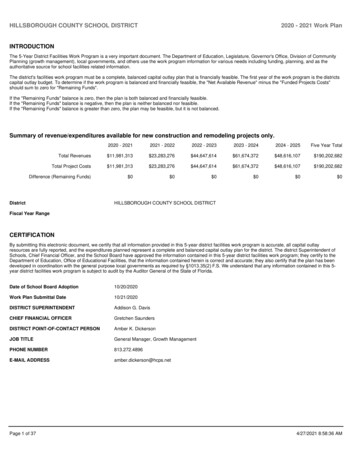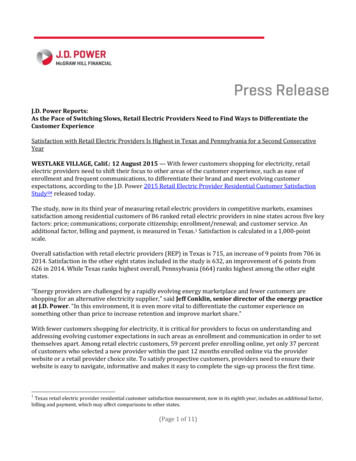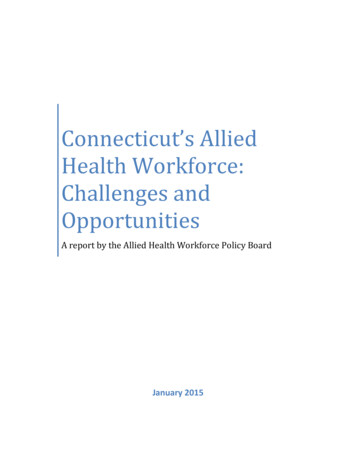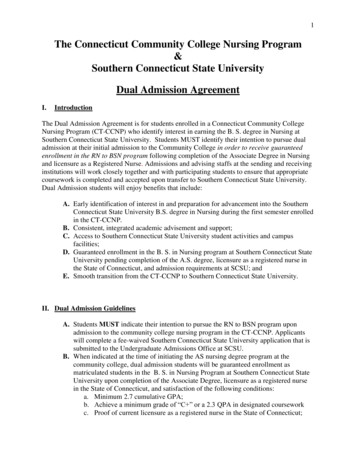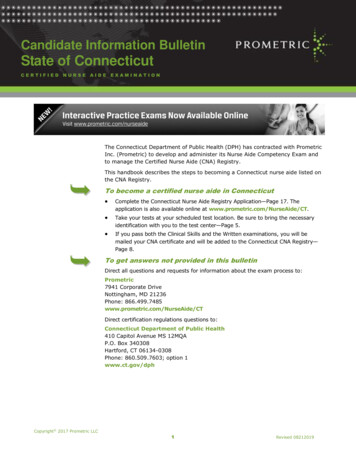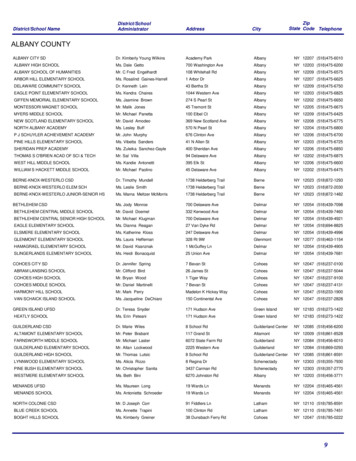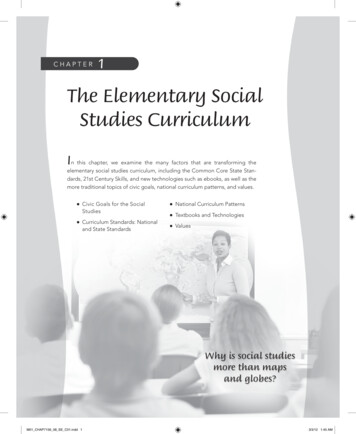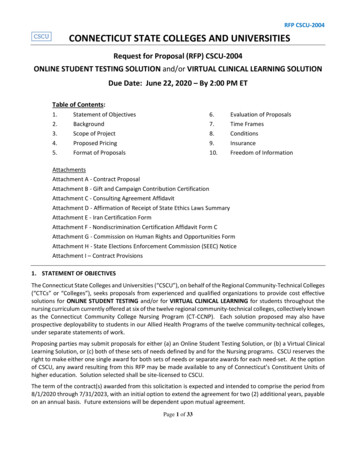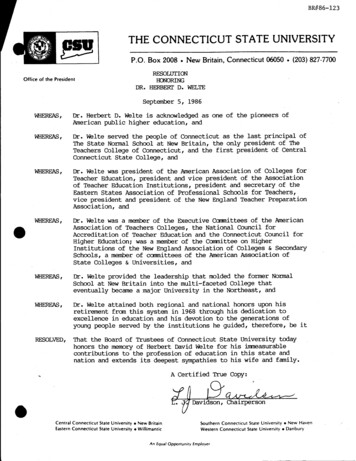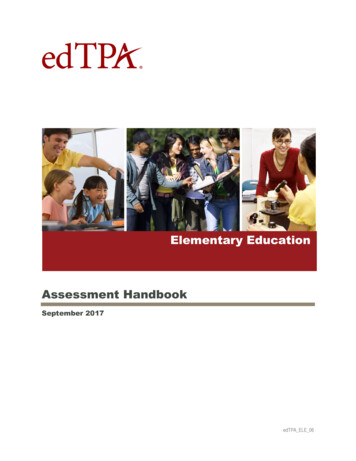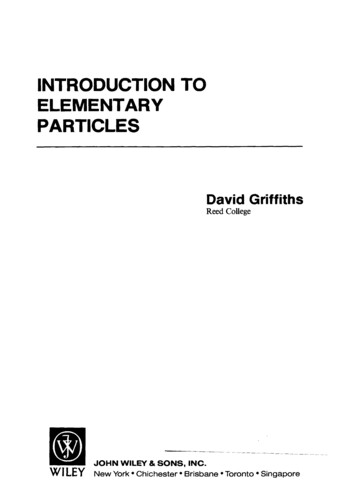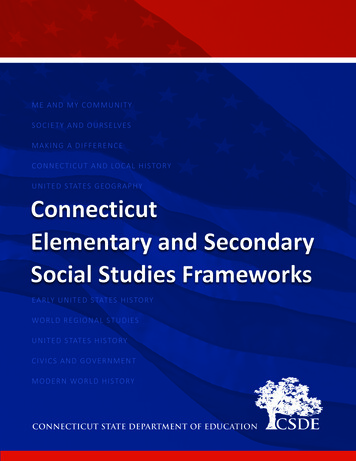
Transcription
M E AN D M Y CO M MU N I T YSOC I ETY AN D O U RSE LV ESM AK I NG A D I F F E R E N CECO NNEC T I CU T A N D LO C A L H I STORYUN I T ED STAT ES G EO G R A P H YConnecticutElementary and SecondarySocial Studies FrameworksEAR LY U NI T E D STAT ES H I STO RYWORL D REG I O N A L ST U D I ESUN I T ED STAT ES H I STO RYCIV I C S AN D G OV E R N ME N TM ODERN WO R LD H I STO RYCONNECTICUT STATE DEPARTMENT OF EDUCATION
CONNECTICUT STATEDEPARTMENT OF EDUCATIONDr. Dianna R. Wentzell, Interim CommissionerDivision of Standards,Curriculum, and InstructionEllen E. CohnInterim Chief Academic OfficerStephen ArmstrongEducation ConsultantOffice of CommunicationsMatthew J. FalconerEditorAndrea WadowskiGraphic Designer
ConnecticutElementary and SecondarySocial Studies FrameworksFebruary 2015
Connecticut Social Studies FrameworksCONTENTSAcknowledgments . 1Introduction . 2Kindergarten — Social Studies: Me and My Community . 9Grade 1 — Social Studies: Society and Ourselves . 19Grade 2 — Social Studies: Making a Difference. 29Grade 3 — Connecticut and Local History . 40Grade 4 — United States Geography . 52Grade 5 — Early United States History. 63Grades 6 and 7 — World Regional Studies . 75Grade 8 — United States History . 87High School — Civics and Government . 101High School — Modern World History. 111High School — United States History. 128
Connecticut Social Studies FrameworksACKNOWLEDGMENTSTHANK YOU TO MEMBERS OF THE CONNECTICUTSOCIAL STUDIES FRAMEWORKS WRITING AND REVIEWING TEAM:Stephen Armstrong, Connecticut StateDepartment of EducationEric Kissinger, Two Rivers AcademyLaura Krenicki, Colchester Public SchoolsJessica Blitzer, West Hartford Public SchoolsCarrie Laudadio, Wallingford Public SchoolsDavid Bosso, Berlin Public SchoolsRebecca Laus, Westport Public SchoolsMichael Breen, Vernon Public SchoolsIan Lowell, Monroe Public SchoolsThomas Brodnitzki, CRECAlan Marcus, University of ConnecticutAshley Callan, West Hartford Public SchoolsMary Clark, CRECValerie McVey, Joint Center for Citizenship,University of Central FloridaSandra Clark, New Haven Public SchoolsMelanie Meehan, Simsbury Public SchoolsDaniel Coughlin, Connecticut Council for theSocial StudiesBeth Milton, Manchester Public SchoolsNora Mocarski, Canton Public SchoolsSally Drew, Central Connecticut State UniversityJennifer Murrihy, Plainville Public SchoolsJames D’Amico, Westport Public SchoolsDavid O’Connor, E.O. Smith High SchoolVanessa Diaz-Valencia, Hartford Public SchoolsJanet Pagoni, Mansfield Public SchoolsAmanda Duffy, Meriden Public SchoolsIan Polun, Tolland Public SchoolsChad Ellis, West Hartford Public SchoolsAnthony Roy, Connecticut River AcademyDanielle Fasciocco, Hartford Public SchoolsCarrie Sabetta, North Branford Public SchoolsAimee Giangrave, Wallingford Public SchoolsJohn Tully, Central Connecticut State UniversityCarrie Grado, Hartford Public SchoolsChris Weaver, West Hartford Public SchoolsMary Hanna, New Canaan Public SchoolsKristi Hummel, CREC Museum AcademyThanks to the many social studies educators who helped to review and approve this document.1
Connecticut Social Studies FrameworksINTRODUCTIONThe new Connecticut Elementary and Secondary Social Studies Frameworks document was entirely createdand written by a team of Connecticut social studies educators. The framework writing team consistedof elementary school, middle school, high school, and college/university faculty. There was a consciousattempt to draw writers from Connecticut’s rural, suburban, and urban districts. This group of Connecticuteducators worked incredibly hard in creating this document and should be commended for their work (for acomplete list of the writing team, see the acknowledgments page).Writing teams met on a continuous basis during the 2013–14 school year and through the summer of 2014. Thedraft framework documents were continuously reviewed during the development process. Review sessions tookplace at several schools, regional educational service centers, and for several specific audiences. Comments fromreviewers were incredibly valuable and were used to strengthen the framework document.It should be noted that the new social studies frameworks are designed to assist curriculum writers at the districtlevel as they write or revise the social studies curriculum for their districts. This document is not intended to bea state curriculum. In a “local control” state such as Connecticut, each district can use the document as it seesfit. However, there is much that is new and exciting in these frameworks, and it is highly recommended that thisdocument be used as a model of curriculum change in any district.THE FOUNDATION OF THE NEW STATE SOCIAL STUDIES FRAMEWORKSThe work of the writing team was guided by the College, Career, and Civic Life (C3) Framework for Social StudiesState Standards: Guidance for Enhancing the Rigor of K-12 Civics, Economics, Geography, and History. The socialstudies frameworks also directly link to the Connecticut (CT) Core Standards.The College, Career, and Civic Life (C3) FrameworkThe C3 framework is a national social studies framework that was introduced in October 2013 and is alignedwith the Common Core State Standards (CCSS). The C3 was created by social studies specialists from all over thecountry; the development of the frameworks originally took place under the direction of the CCSSO (Council ofChief State School Officers) and later under the direction of NCSS (National Council for the Social Studies).The C3 framework states that there are four major disciplines in social studies—civics, economics, geography, and history—and that links to all four disciplines should be found in all social studies courses. This viewis reflected in the Connecticut social studies frameworks. The C3 document also notes the importance ofpsychology, anthropology, and sociology as possible high school elective courses.The National Council for the Social Studies states that there are six guiding principles of the C3 framework: Social studies prepares the nation’s young people for success in college and career, as well as informed,engaged participation in civic life.Inquiry is at the heart of social studies instruction.Social studies involves interdisciplinary instruction and benefits from interaction with and integration ofthe arts and humanities.Social studies is composed of deep and enduring understandings, concepts, and skills from thedisciplines. Social studies instructors should emphasize skills and practices that prepare students forinformed and engaged participation in civic life.2
Connecticut Social Studies Frameworks INTRODUCTION Social studies education has direct and explicit connections to the Common Core State Standards forEnglish/language arts and literacy in history/social studies.The C3 framework informs the process by which states and school districts develop social studiesstandards.A full copy of the C3 framework can be accessed at http://www.socialstudies.org/C3.Connections to the Connecticut Core Standards (CSS)Now referred to as the Connecticut Core Standards in our state, the Common Core State Standards for Englishlanguage arts and literacy in history/social studies, science, and technical subjects outline vital literacy skills thatcan consistently and comprehensively be found in social studies and history classrooms at all grade levels acrossthe state. Social studies as a discipline naturally allows students to master key reading, writing, analysis, speakingand listening skills that are outlined in the common core literacy standards. Because of this natural connection, ithas been noted which CT Core Standards are integrated into each section of the social studies framework at eachgrade level. The Literacy in History/Social Studies, Science, and Technical Subjects standards can be accessed atCCSS.ELA-Literacy.RH.6-8, CCSS.ELA-Literacy.RH.9-10, and CCSS.ELA-Literacy.RH.11-12.Dimension of InquiryConnecticut Core StandardsDeveloping questions and planning inquiryR1, W7, SL1Applying disciplinary concepts and toolsR1-10, W1, W2, W7, SL1, L1-3, L6Evaluating sources and using evidenceR1-10, W1, W2, W7-10, SL1, L1-3Communicating conclusions and taking informed actionR1, W1-8, SL1-6, L1-3Links to the Connecticut Core Standards can be found in the frameworks for all grade levels. As stated, theConnecticut Social Studies frameworks use social studies literacy skills found in the Connecticut Core Standards;at the same time, it should be noted that the social studies frameworks were developed independently fromthe Connecticut Core Standards and include many skills and content connections not found in the ConnecticutCore Standards. It is also important that social studies teachers use the ELA College and Career Readiness AnchorStandards, especially the anchor standards for speaking and listening and language.The Inquiry ProcessThe inquiry process is absolutely critical for effective student understanding of history, geography, civics, andeconomics, and is emphasized throughout this frameworks document. Inquiry should guide the teaching ofsocial studies at all levels. By our definition, inquiry instruction is based on both teachers and students asking(and answering) compelling questions; social studies instruction should consist of more than a teacher solelytelling students “what they need to know.” Student investigation of subject matter is the most critical componentof inquiry. Teachers must carefully guide students through the inquiry process, but true inquiry allows studentsto construct their own questions and, with the guidance and support of skilled teachers, conduct inquiry ontheir own. Inquiry eliminates the old “skills vs. content” dilemma; to successfully engage in an inquiry activity,students and teachers will have to use both. The social studies frameworks emphasize these skills in the serviceof helping students discover rich social studies content. Inquiry should not be the only method of instructionthat a teachers uses in a social studies classroom, but it should be used on a consistent and regular basis.3
Connecticut Social Studies Frameworks INTRODUCTIONAs noted above, initially the teacher will engage the students in inquiry through a compelling question. By ourdefinition, a compelling question: Is a question that a specialist studying that era or subject would ask.Is a question that is written in student-friendly language.Is a question that will excite students about the subject being studied.The framework document provides sample compelling questions (to guide inquiry) for each grade. For eachcompelling question, we also provide a series of supporting questions; these are often content-based questionsthat help students and teachers tackle the more complex compelling questions.As mapped out in the C3 national frameworks, there are four separate Dimensions of Inquiry: Dimension 1: Developing questions and planning inquiryDimension 2: Applying disciplinary concepts and tools (this is where “content” is absolutely critical)Dimension 3: Evaluating sources and using evidenceDimension 4: Communicating conclusions and taking informed actionThis four-step process is known as the Inquiry Arc. Whenever possible, all four stages of the process should beaddressed in an inquiry activity. In the past, social studies classes often began and ended with the content ofwhat students should know. Over time, we have added the skills expectation of what students should be able todo. Within that scope, the Connecticut frameworks ask students “to do” by not only communicating conclusionsin essays and presentations for the classroom or the teacher, but also to take informed action within the school,local, state, and national communities.Many social studies educators find Dimension 4, Taking Informed Action, as the most exciting and empoweringfor their students. Examples of Taking Informed Action are: Students investigating fair trade policies attend a meeting of local businesses to advocate their positionon fair trade goods.Students investigate zoning and other ordinances, construct a proposal for a new skate board park intheir community, and present this proposal to the Town Council for action.Students investigate the history of Columbus’s exploration and write editorials to their local newspaperor attend a Board of Education meeting to discuss whether the town and school should celebrateColumbus Day.Students studying a modern American war make a proposal to honor veterans by interviewing localveterans and establishing a local archive of these interviews.Students investigate what is done in other classes in their school and establish a new set of rules forbehavior in their classroom.Students use inquiry skills to construct history-related projects and enter them in a regional History Daycompetition.Civic engagement is one of the most essential tasks of social studies education. It is critically important thatstudents at the elementary school, middle school, and high school levels learn more about government at thenational, state, and local levels. It is also important that students learn about their responsibilities as globalcitizens. It is equally important that students have the opportunity to “take informed action.” Students shouldnot just learn about government; they should be encouraged to participate in democratic processes. Taking partin student government, model congresses, service projects, and classroom simulations are all ways that allowstudents to participate in civil society and not just to learn about how civil society works. It is possible, even atthe elementary school level, for students to “make a difference” in society.4
Connecticut Social Studies Frameworks INTRODUCTIONAs students learn to take informed action, it is important that social studies teachers help students take part ingrade- and age-appropriate projects and activities. In addition, students should have some say in planning theseactivities; by doing this teachers further reinforce the democratic nature of taking informed action.The Critical Component: Instructional Shifts of the FrameworksThese frameworks represent a substantial shift in the way that social studies was most commonly taught in thepast. To meet the changing needs of students in the Information Age, and to prepare them for the challenges ofa dynamic world environment, the following instructional shifts are necessary:1. Inquiry should be a primary form of instruction in all social studies classes.2. Student (and teachers) should craft investigative questions that matter.3. Teachers should establish a collaborative context to support student inquiry.4. Teachers should integrate content and skills meaningfully.5. Teachers should help students articulate disciplinary literacy practices and outcomes (thinking, reading,writing, speaking like a historian, like a geographer, like an economist, etc.).6. Teachers should provide, and help students develop, tangible opportunities to take informed action.Using State and Local HistoryThe writers of this framework strongly suggest using local and state history wherever and whenever possiblewhen teaching United States history in elementary school, middle school, and high school. The study of local andstate history will help students develop a sense of place and a sense of connection to the community where theylive and go to school. Many students will be surprised when they discover historical events that occurred in theirown state and communities.We suggest using local and state history as windows into the larger themes of United States history and to uselocal/state examples whenever possible. We strongly suggest that teachers use critical resources found at localhistorical societies, museums, and other historic sites. Professional development activities will be forthcomingfor teachers to learn more about Connecticut and local history.District Decision-MakingAlthough the instructional shifts and the inquiry process described above are central to the Connecticut socialstudies frameworks, there are many curricular decisions that will take place at the district level. For example,offering elective coursework at the high school level in areas not included in the four key disciplines of the C3framework, such as psychology or sociology, will be decided by districts. Even within the suggested coursework,there may be elective options. For instance, the civics requirement may be fulfilled by a course in Americangovernment, legal studies, or political science. Districts are free to make decisions based on student and localinterests as well as teacher expertise. Some districts may choose to require more than one year of high schoolWorld History while others may wish to embed more World History content in Grades 6 and 7. As noted above,questions concerning curriculum and sequencing of courses should be made by district-level teachers andadministrators.5
Connecticut Social Studies Frameworks INTRODUCTIONBelow is the suggested K–12 sequence:SAMPLE K–12 SEQUENCEGradeC3 Discipline of FocusContent StudyKindergartenEconomicsGeographyHistoryCivicsMe and My Community: Home, Class, School, and Towncommunities are studied (ex. class and school rules, mapsof neighborhoods and town)Grade 1EconomicsGeographyHistoryCivicsCommunity Beyond My Neighborhood (including International): Compare communities from around the state,nation, and globe to our own.Grade 2EconomicsGeographyHistoryCivicsMaking a Difference (local/state/national/international):Examining the people that make, and have made a difference. Examining the concept that ALL people can make adifference.Grade 3EconomicsGeographyHistoryCivicsConnecticut and Our Town: Past and PresentGrade 4EconomicsGeographyHistoryCivicsGeographic Themes and U.S. GeographyAn introduction to all four disciplines of the C3 framework should be introduced in the primary grades.This would include, but is not limited to, the use of maps, globes, the rights and responsibilities of groups,perspectives on the past, local history, and economic decision-making.Grade 5HistoryUS History I: the Earliest Settlements in North America, Colonial United States History, and the American RevolutionGrade 6*GeographyWorld Regional Studies: the West (using the lens of geography to examine past and present features of people andnations in different regions of the world) Grade 7*GeographyMiddle America and the CaribbeanSouth AmericaWestern EuropeEastern EuropeWorld Regional Studies: the East (includes geography, selected points of history, and current events/culture) Sub-Saharan AfricaThe Middle East and North AfricaSubcontinental AsiaEast Asia* A district could take several approaches to Grades 6/7; this is just one example. For districts wishing toembed the history of ancient civilizations (e.g., Egypt, Greece, China, Aztecs) into their K–12 sequence,this could be an appropriate place.6
Connecticut Social Studies Frameworks INTRODUCTIONGrade 8HistoryUS History II: the American Revolution—Trans-MississippiWestward InteractionHigh SchoolHistoryHistoryCivicsModern World History: Industrial Era–PresentUS History III: The Gilded Age - PresentAmerican GovernmentEconomicsGeographyHistoryCivicsSocial SciencesElective CourseworkUSING THE FRAMEWORK DOCUMENTSAll the frameworks documents are organized in exactly the same manner. You will see references to ConnecticutCore Standards and C3 social studies frameworks throughout. In each document, you will find: A list of course compelling questions that should guide instruction and research in that particular courseor grade. All units and lessons during the year should help students address one or more of these compelling questions. Note: for the three years of United States history (Grade 5, Grade 8, high school) thecompelling questions are the same; these will obviously be addressed with varying levels of complexity.A list of Considerations for Curriculum Development that will suggest curriculum connections across andbetween grades and courses.A description of the C3 Inquiry Arc, including student expectations for each of the dimensions. As notedabove, inquiry should be a critical component of social studies instruction at all grade levels.A list of themes and content for each course, as well as end-of-course compelling questions that mightbe used for research and/or discussion.A detailed summary of the content expectations for each course. On the left side of each content summary, there is a description of themes that a teacher can use throughout a course, applying one or morethemes to each unit. On the right side of each content summary, there is a description of “units” and unitexpectations. Teachers should be encouraged to combine themes and content in their instruction.A list of the history themes, economics themes, civics themes, and geography themes that should beaddressed in the course. The themes are adopted from the C3 framework.A list of possible inquiry questions (called “compelling questions”) that might be addressed in the course.Compelling questions are included for the disciplines of economics, history, civics and geography.Supporting questions for each compelling question are also included; these are questions that would bediscussed/researched that would allow students to tackle the compelling (inquiry) question that they areattached to; these should be discussed/researched before students are asked to address the associatedcompelling question. C3 themes and student expectations that each compelling question addresses arealso included. It should be noted that these are sample compelling questions; curriculum developers atthe district level should develop similar questions for all courses.7
Connecticut Social Studies Frameworks INTRODUCTIONNEXT STEPSBeginning early in 2015, substantial professional development will be provided for social studies teachers andsocial studies departments. Professional development will be provided on the frameworks as a whole andon using inquiry in the social studies classroom. The frameworks state that local and state history should beincluded in all United States history courses. Local and state history will be a focus of separate professional development activities. Some teachers have stated the need for professional development on infusing economics intothe social studies curriculum. Specific professional development will also be provided on this topic. A webinarseries will also be created on infusing inquiry and the new frameworks into new and existing social studiescurriculum documents.There are districts that want more guidance on inquiry activities, suggestions for specific content, and assessment. A companion document will be created that will go into more depth on what the specifics might be in asocial studies curriculum. We will take each of the grade-level documents and go “deeper” into each of them.We will provide an essay from a Connecticut scholar on what should be included at each grade level. We willhave a follow-up essay by one or two “master teachers” who teach that grade; this essay will build off the essayof the scholar and explain practical approaches to teaching essential content and skills at each specific gradelevel. We will then have a list of essential primary sources and other resources for that grade. We will also bepublishing a separate document on the critical inquiry dimension of “taking informed action” and how thatmight be done at each grade level.8
Connecticut Social Studies FrameworksKINDERGARTEN — SOCIAL STUDIES: ME AND MY COMMUNITYIn Kindergarten, students engage in the study of themselves, their families, and their communities andlearn how to participate and use effective citizenship skills. They will explore their classrooms, schools,neighborhoods, and home communities through an interdisciplinary approach including history, civics,economics, and geography. The study of themselves, their families, and their communities requires that studentsgenerate and research compelling questions such as: What is my role in my community? What is “history” and how is the past different from the present? How are we connected to the past?Considerations for Curriculum Development1. It is expected that students in Kindergarten will establish a basic understanding of family structures,rules/consequences in school and society, and citizenship in school and community.2. It is expected that students in the primary grades will establish a fundamental understanding ofgeography and the use of maps and globes.3. It is expected that elementary school students will use local and state geography as a comparison to thegeographical themes of various U.S. regions.4. It is expected that elementary school students will explore history, geography, civics, and economicsthrough multiple perspectives and viewpoints.5. It is expected that students engage in activities that promote the development of research, reading,writing, speaking, and listening skills as part of the inquiry arc.6. It is expected that elementary students will explore ways to practice democracy and methods ofparticipation in society.9
Connecticut Social Studies Frameworks KINDERGARTEN — SOCIAL STUDIES: ME AND MY COMMUNITYINQUIRY IN THE SOCIAL STUDIESInquiry Numbering SystemINQK–2.1InquiryGrade levelIndicator numberDIMENSION 1: DEVELOPING QUESTIONS AND PLANNING INQUIRYCentral to a rich social studies experience is the capability for developing questions that can frame and advanceinquiry. Those questions come in two forms: compelling and supporting questions (C3, p. 23–25).It is expected that students in Social Studies: Me and My Community (Kindergarten) will individually and with others:INQ K–2.1 Explain why the compelling question is important to the student.INQ K–2.2 Identify disciplinary ideas associated with a compelling question.INQ K–2.3 Identify facts and concepts associated with a supporting question.INQ K–2.4 Make connections between supporting questions and compelling questions.INQ K–2.5 Determine the kinds of sources that will be helpful in answering compelling questions and supportingquestions.CT Core Standards: CCSS.ELA-Literacy.RI.K.1, CCSS.ELA-Literacy.W.K.7, CCSS.ELA-Literacy.SL.K.1Key academic vocabulary: questioning, opinion (argument), explanation, point of viewDIMENSION 2: APPLYING DISCIPLINARY CONCEPTS AND TOOLS(See Dimension 2 in pages below)DIMENSION 3: EVALUATING SOURCES AND USING EVIDENCEStudents need to analyze information and come to conclusions in an inquiry. These skills focus on gathering andevaluating sources, and then developing claims and using evidence to support these claims (C3, p.53–55).It is expected that students in Social Studies: Me and My Community (Kindergarten) will individually and with others:INQ K–2.6 Gather relevant information from one or two sources while using the origin and structure to guide theselection.INQ K–2.7 Evaluate a source by distinguishing between facts and opinion.INQ K–2.8 (begins in Grades 3–5)INQ K–2.9 (begins in Grades 3–5)CT Core Standards: CCSS.ELA-Literacy.RI.K.1-10, CCSS.ELA-Literacy.W.K.1-2, CCSS.ELA-Literacy.W.K.7-10, CCSS.ELA-Literacy.SL.K.1-3Key academic vocabulary: opinion (argument), shared research, gather, sources, evidence, clarify10
Connecticut Social Studies Frameworks KINDERGARTEN — SOCIAL STUDIES: ME AND MY COMMUNITYDIMENSION 4: COMMUNICATING CONCLUSIONS AND TAKING INFORMED ACTIONStudents should construct and communicate claims for a variety of purposes and audiences. These audiencesmay range from the school classroom to the larger public community (C3, p. 59–62).It is expected that students in Social Studies: Me and My Community (Kindergarten) will individually and withothers:INQ K–2.10 Construct an argument with reasons.INQ K–2.11 Construct explanations using correct sequence and relevant information.INQ K–2.12 Present a summary of an argument using print, oral, and digital technologies.INQ K–2.13 Ask and answer questions about arguments.INQ K–2.14 Ask and answer questions about explanations.INQ K–2.15 Identify and explain a range of local, regional, and global problems, and some ways in which peopleare trying to address these problems.INQ K–2.16 Identify ways to take action to help address local, regional, and global problems.INQ K–2.17 Use listening, consensus-building, and voting procedures to decide on and take action in their classrooms.CT Core Standards: CCSS.ELA-Literacy.RI.K.1, CCSS.ELA-Literacy.W.K.1-8, CCSS.ELA-Literacy.SL.K.1-6, CCSS.ELA-Literacy.L.K.1-3Key academic vocabulary: opinion, explanation, collaborative conversations, evidence, claims, visually/visualize11
Connecticut Social Studies Frameworks KINDERGARTEN — SOCIAL STUDIES: ME AND MY COMMUNITYTHEMES AND CONTENTOutlined below are themes and content recommended when developing a Kindergarten course. A comprehen-sive study of Me and My Community can be approached from many angles and perspectives. When writinga course curriculum, distri
Social studies as a discipline naturally allows students to master key reading, writing, analysis, speaking and listening skills that are outlined in the common core literacy standards. Because of this natural connection, it has been noted which CT Core Standards are integrated into each section of the social studies
